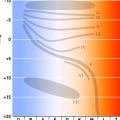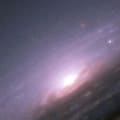Stars, the luminous spheres of gas that populate our universe, undergo a fascinating life cycle that spans billions of years. From their humble beginnings in vast clouds of gas and dust to their dramatic endings as white dwarfs, neutron stars, or black holes, the journey of a star is determined primarily by its initial mass. Understanding this cosmic process not only reveals the origins of the elements that make up our world but also provides insights into the evolution of galaxies and the universe itself.
Star Formation Process

The formation of stars begins in vast molecular clouds known as nebulae, which are primarily composed of hydrogen and helium gas along with interstellar dust [1][2][3]. These clouds can span hundreds of light-years across and contain enough material to form thousands of stars. The process of star formation unfolds through several key stages:
Giant Gas Cloud: The initial stage involves the gravitational collapse of a portion of the nebula [1][2]. As gravity pulls the gas and dust particles together, they begin to form denser regions within the cloud [4].
Protostar Formation: As the cloud continues to contract, its core becomes increasingly hot and dense. This collapsing core forms a protostar, which is the earliest stage of stellar evolution [1][2][3][4]. The protostar phase can last for about 100,000 years, during which the object continues to accumulate mass from the surrounding cloud through a process called accretion.
T-Tauri Phase: Before nuclear fusion begins in the core, the protostar enters the T-Tauri phase. During this stage, which can last up to 100 million years, the star's energy comes solely from gravitational contraction [2][4]. T-Tauri stars are characterized by their variability in brightness and strong stellar winds [3].
Main Sequence Ignition: When the core temperature reaches approximately 15 million degrees Celsius, nuclear fusion of hydrogen into helium begins. This marks the birth of a true star and its entry into the main sequence stage [4][1][2]. Throughout this process, the interplay between gravity and internal pressure is crucial. As the protostar contracts, its core temperature and pressure increase, eventually reaching the point where nuclear fusion can occur.
It's important to note that not all collapsing gas clouds result in successful star formation. Some may form brown dwarfs, objects too small to sustain hydrogen fusion in their cores. Additionally, the star formation process can create multiple stars from a single cloud, leading to the formation of binary or multiple star systems. The entire process of star formation, from the initial cloud collapse to the ignition of fusion, typically takes several million years [2]. This timescale is relatively short compared to the billions of years that stars spend in their main sequence phase, highlighting the dynamic nature of stellar birth in the cosmos.
Main Sequence Stability

The main sequence is the longest and most stable phase in a star's life cycle, characterized by the continuous fusion of hydrogen into helium in the star's core. This stage accounts for about 90% of a star's lifetime [1]. During this period, a star achieves a delicate balance between the outward pressure generated by nuclear fusion and the inward pull of gravity, maintaining its size and luminosity.
The duration of a star's main sequence phase is inversely proportional to its mass. More massive stars burn through their hydrogen fuel much faster due to higher core temperatures and pressures, resulting in shorter lifespans. For instance, a star 10 times more massive than the Sun may only spend a few million years on the main sequence, while a star with half the Sun's mass could remain there for tens of billions of years [1][2].
Our Sun, a typical main sequence star, has been in this phase for about 4.6 billion years and is expected to continue for another 5 billion years [3]. During this time, it converts approximately 600 million tons of hydrogen into helium every second through nuclear fusion. This process not only provides the energy that sustains life on Earth but also maintains the Sun's stability.
Main sequence stars are classified according to their spectral type, which is determined by their surface temperature and correlates with their mass. The spectral sequence, from hottest to coolest, is O, B, A, F, G, K, M. Our Sun is a G-type star, with a surface temperature of about 5,500°C.
As stars progress through the main sequence, subtle changes occur. The core gradually becomes enriched with helium "ash" from hydrogen fusion, causing it to contract slightly and become hotter. This leads to a slow increase in the star's luminosity over time. For instance, our Sun is estimated to be about 30% brighter now than when it first entered the main sequence [3].
The main sequence phase ends when a star exhausts the hydrogen fuel in its core. At this point, the star begins to fuse hydrogen in a shell around the helium core, marking the beginning of its evolution into a red giant [2].
Red Giant Expansion

When a star exhausts the hydrogen fuel in its core, it enters the red giant phase - a dramatic period of expansion and cooling. This stage marks a significant transition in the star's life cycle and unfolds differently depending on the star's initial mass.
For stars like our Sun, the process begins when hydrogen fusion ceases in the core. As the core contracts and heats up, it ignites hydrogen fusion in a shell surrounding the helium core. This shell burning causes the star's outer layers to expand dramatically, increasing the star's radius by hundreds of times [1]. As the surface area increases, it cools and takes on a reddish hue, hence the term "red giant".
During this expansion, the star's luminosity increases significantly. A red giant can be thousands of times more luminous than its main sequence counterpart, despite having a cooler surface temperature [2]. This increased energy output is due to the larger radiating surface area and the energy released from gravitational contraction.
For more massive stars, the red giant phase is even more extreme. These stars become red supergiants, expanding to sizes that could engulf the orbit of Mars if placed at the center of our solar system [3]. The most massive stars may skip the red supergiant phase entirely, instead becoming blue supergiants or Wolf-Rayet stars.
As the helium core continues to contract and heat up, it eventually reaches temperatures high enough (about 100 million Kelvin) to ignite helium fusion, producing carbon and oxygen [1]. For low to intermediate-mass stars, this ignition occurs dramatically in an event called the helium flash. More massive stars transition to helium burning more smoothly.
The red giant phase is relatively short-lived compared to the main sequence, lasting only a few hundred million years for Sun-like stars. During this time, the star may experience periods of instability and mass loss through stellar winds. These winds enrich the surrounding interstellar medium with heavier elements, contributing to the chemical evolution of the galaxy [2].
The fate of a star after the red giant phase depends on its mass. Low to intermediate-mass stars will eventually shed their outer layers, forming a planetary nebula and leaving behind a white dwarf. More massive stars will continue to fuse increasingly heavier elements in their cores, eventually leading to a supernova explosion [3].
Supernova and Final Stages

The final stages of a star's life are determined by its initial mass, with the most dramatic endings reserved for the most massive stars. These culminating events play a crucial role in enriching the universe with heavy elements and shaping the evolution of galaxies.
For stars with masses greater than about 8 times that of the Sun, the end comes in the form of a supernova explosion. As these massive stars progress through their life cycles, they continue to fuse increasingly heavier elements in their cores, from helium to carbon, oxygen, and eventually iron. Once iron fusion begins in the core, the star is doomed, as iron fusion consumes rather than releases energy [1].
The iron core grows until it reaches the Chandrasekhar limit (about 1.4 solar masses), at which point it can no longer support itself against gravity. In a fraction of a second, the core collapses, and the outer layers of the star fall inward at tremendous speeds. This collapse is halted when the core reaches nuclear densities, causing a rebound that sends a shockwave outward. This shockwave, combined with a flood of neutrinos from the collapsing core, triggers a massive explosion known as a Type II supernova.
During a supernova, the star briefly outshines entire galaxies and expels most of its material into space, spreading heavy elements throughout the cosmos. These elements form the building blocks for future generations of stars and planets, including the elements necessary for life as we know it [2].
The remnant left behind after a supernova depends on the initial mass of the star:
- For stars between about 8 and 20 solar masses, the core collapses to form a neutron star - an incredibly dense object where a teaspoon of material would weigh billions of tons on Earth [1].
- For stars more massive than about 20 solar masses, the core collapse continues past the neutron star stage, forming a black hole - an object so dense that not even light can escape its gravitational pull [2].
Some neutron stars, if they're rotating rapidly, become pulsars - cosmic lighthouses that emit beams of radiation as they spin. For less massive stars (like our Sun), the end is less dramatic but still significant. These stars expand into red giants, eventually shedding their outer layers to form planetary nebulae [3]. The exposed core, no longer able to sustain fusion, becomes a white dwarf - a small, dense star about the size of Earth. White dwarfs slowly cool over billions of years, eventually becoming dim, cold black dwarfs [2].
These final stages of stellar evolution are crucial for understanding the life cycle of matter in the universe. Supernovae and planetary nebulae disperse heavy elements into space, enriching the interstellar medium from which new stars and planets form [3]. This cosmic recycling process ensures that each generation of stars is more metal-rich than the last, driving the chemical evolution of galaxies and ultimately leading to the conditions necessary for life to emerge [4].

Comments
Post a Comment